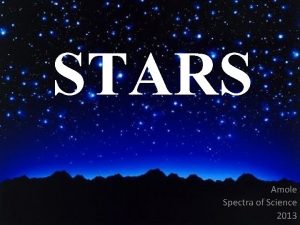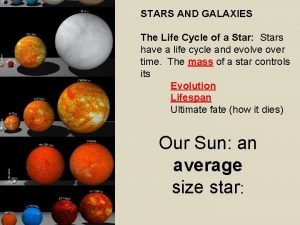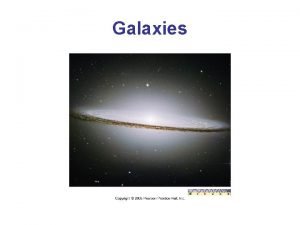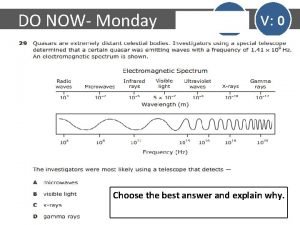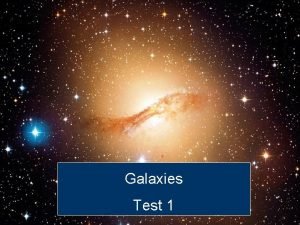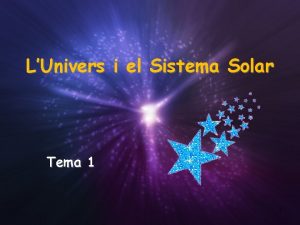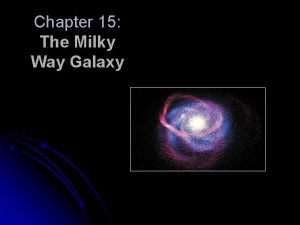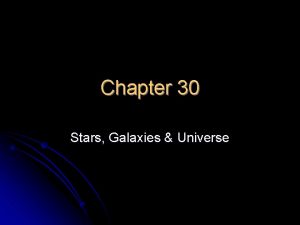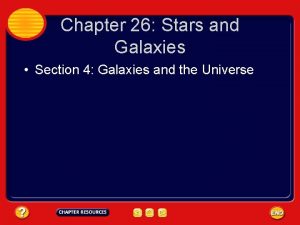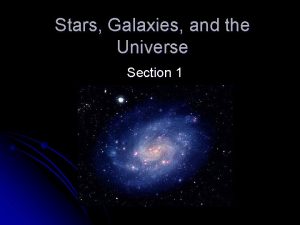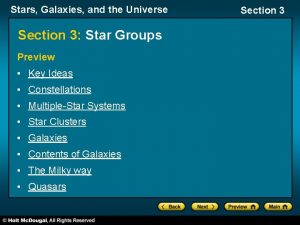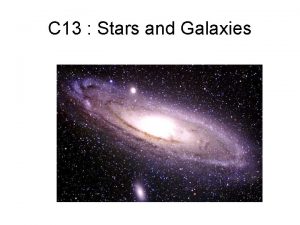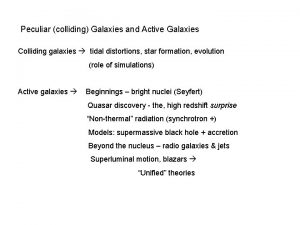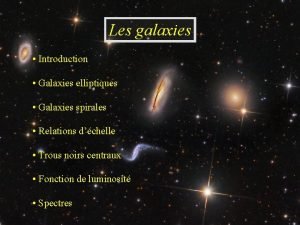Stars Galaxies and the Universe Section 1 Characteristics


















- Slides: 18

Stars, Galaxies, and the Universe Section 1: Characteristics of Stars Preview • Key Ideas • Analyzing Starlight • Stellar Motion • Distances to Stars • Light-Year • Stellar Brightness • Absolute and Apparent Motion Section 1

Stars, Galaxies, and the Universe Section 1 Key Ideas • Describe how astronomers determine the composition and temperature of stars. • Explain why stars appear to move in the sky. • Describe one way astronomers measure the distances to stars. • Explain the difference between absolute magnitude and apparent magnitude.

Stars, Galaxies, and the Universe Section 1 Analyzing Starlight • star a large celestial body that is composed of gas and that emits light. • Nuclear fusion is the combination of light atomic nuclei to form heavier atomic nuclei • Astronomers learn about stars primarily by analyzing the light that the stars emit. • Starlight passing through a spectrograph produces a display of colors and lines called a spectrum.

Stars, Galaxies, and the Universe Section 1 Analyzing Starlight, continued • All stars have dark-line spectra, which are bands of color crossed by dark lines where the color is diminished. • A star’s dark-line spectrum reveals the star’s composition and temperature. • Stars are made up of different elements in the form of gases. • Because different elements absorb different wavelengths of light, scientists can determine the elements that make up a star by studying its spectrum.

Stars, Galaxies, and the Universe Section 1 Analyzing Starlight, continued The Compositions of Stars • Scientists have learned that stars are made up of the same elements that compose Earth. • The most common element in stars is hydrogen. • Helium is the second most common element in star. • Small quantities of carbon, oxygen, and nitrogen are also found in stars.

Stars, Galaxies, and the Universe Section 1 Analyzing Starlight, continued The Temperatures of Stars • The surface temperature of a star is indicated by its color. • Most star temperatures range from 2, 800 ˚C to 24, 000 ˚C. • Blue stars have average surface temperatures of 35, 000 ˚C. • Yellow stars, such as the sun, have surface temperatures of about 5, 500 ˚C. • Red stars have average surface temperatures of 3, 000 ˚C.

Stars, Galaxies, and the Universe Section 1 Analyzing Starlight, continued The Sizes and Masses of stars • Stars vary in size and mass. • Stars such as the sun are considered medium-sized stars. The sun has a diameter of 1, 390, 000 km. • Most of the stars you can see in the night sky are medium-sized stars. • Many stars also have about the same mass as the sun, however some stars may be more or less massive.

Stars, Galaxies, and the Universe Section 1 Stellar Motion Apparent Motion • The apparent motion of stars, or motion as it appears from Earth, is caused by the movement of Earth. • The stars seem as though they are moving counterclockwise around a central star called Polaris, the North Star. Polaris is almost directly above the North Pole, and thus the star does not appear to move much. • Earth’s revolution around the sun causes the stars to appear to shift slightly to the west at a given time every night.

Stars, Galaxies, and the Universe Section 1 Stellar Motion, continued Reading Check Why does Polaris appear to remain stationary in the night sky? Polaris is almost exactly above the pole of Earth’s rotational axis, so Polaris moves only slightly around the pole during one rotation of Earth.

Stars, Galaxies, and the Universe Section 1 Stellar Motion, continued Circumpolar Stars • Some stars are always visible in the night sky. These stars never pass below the horizon. • In the Northern Hemisphere, the movement of these stars makes them appear to circle the North Star. • These circling stars are called circumpolar stars.

Stars, Galaxies, and the Universe Section 1 Stellar Motion, continued Actual Motion of Stars • Most stars have several types of actual motion. • Stars move across the sky (seen only for close stars). • Some stars may revolve around another star. • Stars either move away from or toward our solar system.

Stars, Galaxies, and the Universe Section 1 Stellar Motion, continued Actual Motion of Stars • Doppler effect an observed change in the frequency of a wave when the source or observer is moving • The spectrum of a star that is moving toward or away from Earth appears to shift, due to the Doppler effect. • Stars moving toward Earth are shifted slightly toward blue, which is called blue shift. • Stars moving away from Earth are shifted slightly toward red, which is called red shift.

Stars, Galaxies, and the Universe Section 1 Stellar Motion, continued The spectrum of a star that is moving toward or away from Earth appears to shift, as shown in the diagram below.

Stars, Galaxies, and the Universe Section 1 Distances to Stars • Distances between the stars and Earth are measured in light-years. • light-year the distance that light travels in one year. • Because the speed of light is 300, 000 km/s, light travels about 9. 46 trillion km in one year. • For relatively close stars, scientists determine a star’s distance by measuring parallax. • parallax an apparent shift in the position of an object when viewed from different locations.

Stars, Galaxies, and the Universe Light-Year Click below to watch the Visual Concept. Section 1

Stars, Galaxies, and the Universe Section 1 Stellar Brightness • apparent magnitude the brightness of a star as seen from the Earth • The apparent magnitude of a star depends on both how much light the star emits and how far the star is from Earth. • absolute magnitude the brightness that a star would have at a distance of 32. 6 light-years from Earth • The brighter a star is, the lower the number of its absolute magnitude.

Stars, Galaxies, and the Universe Section 1 Stellar Brightness The lower the number of the star on the scale shown on the diagram below, the brighter the star appears to observers.

Stars, Galaxies, and the Universe Absolute and Apparent Motion Click below to watch the Visual Concept. Section 1
 Chapter 30 galaxies and the universe
Chapter 30 galaxies and the universe Edwin hubble
Edwin hubble Types of stars
Types of stars Mary daniels is a student in england
Mary daniels is a student in england Galaxie s
Galaxie s Life cycle of galaxies
Life cycle of galaxies Elliptical galaxies facts
Elliptical galaxies facts Galaxies
Galaxies The pity relation for an adiabatic expansion is
The pity relation for an adiabatic expansion is Milky way galaxy shape
Milky way galaxy shape Types of galaxies
Types of galaxies Brainpop galaxies quiz answers
Brainpop galaxies quiz answers 4 types of galaxies
4 types of galaxies How are active galaxies classified?
How are active galaxies classified? Tipus de galaxies
Tipus de galaxies Type of galaxy
Type of galaxy Evolution of galaxies
Evolution of galaxies Billions of galaxies
Billions of galaxies Galaxies lesson plan
Galaxies lesson plan


